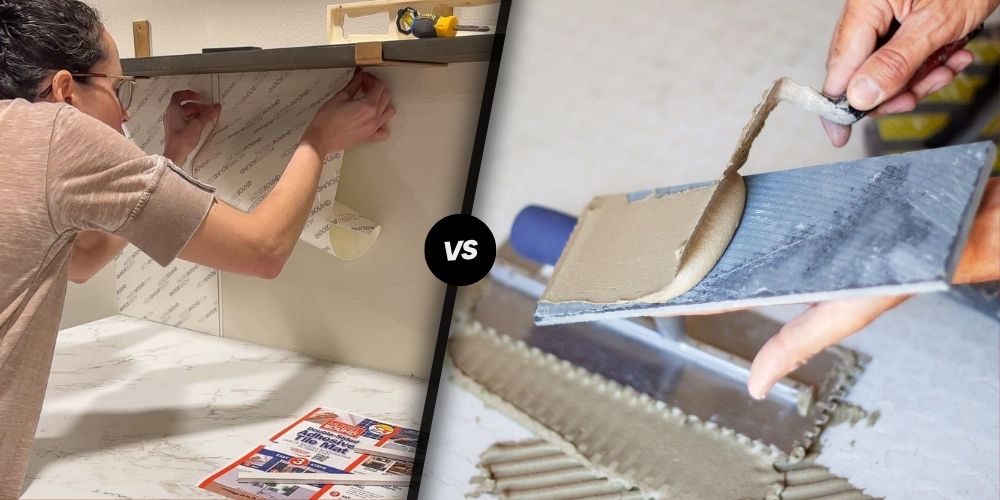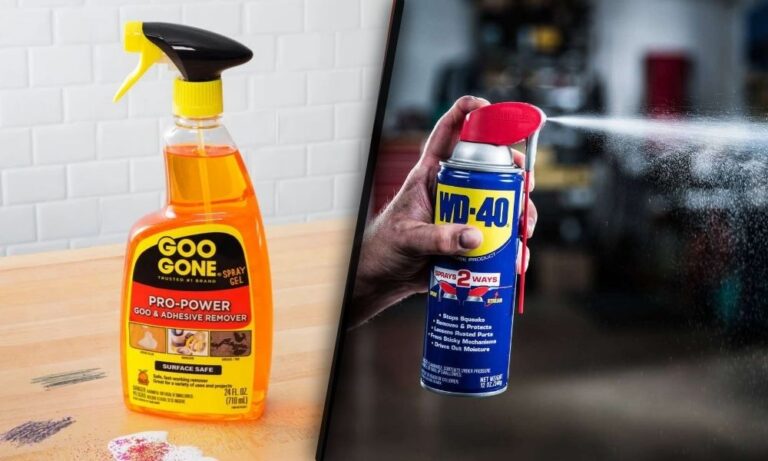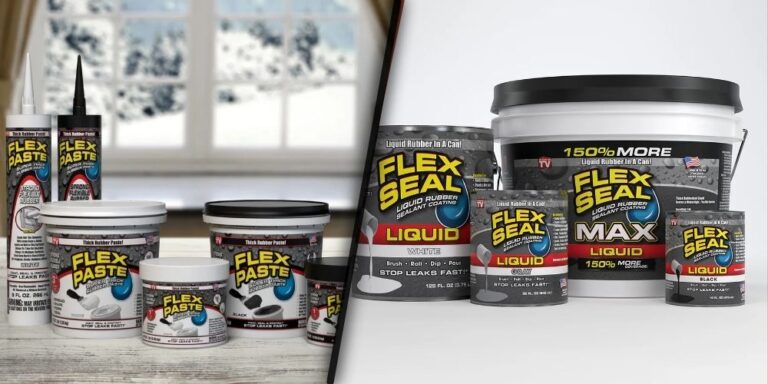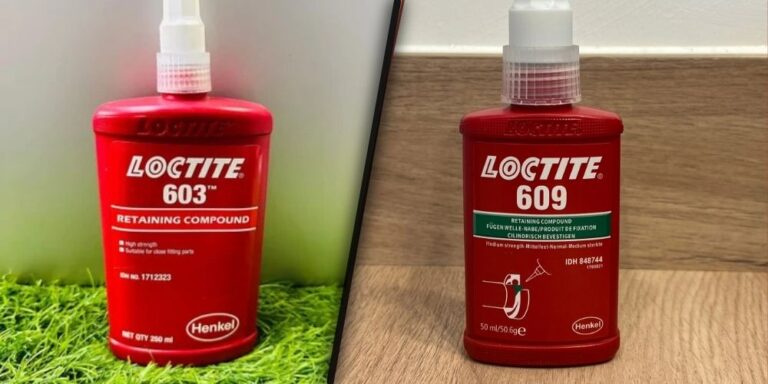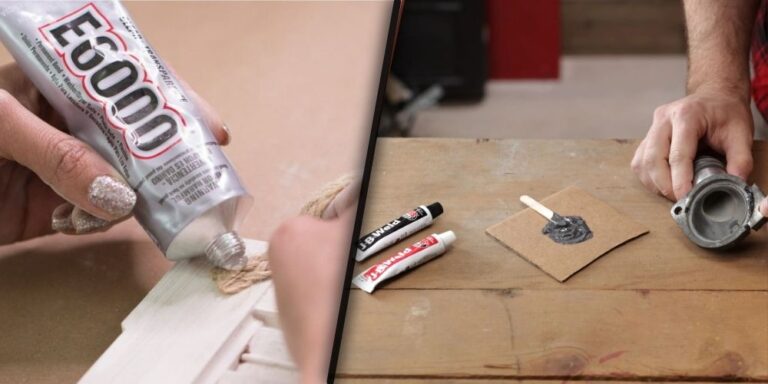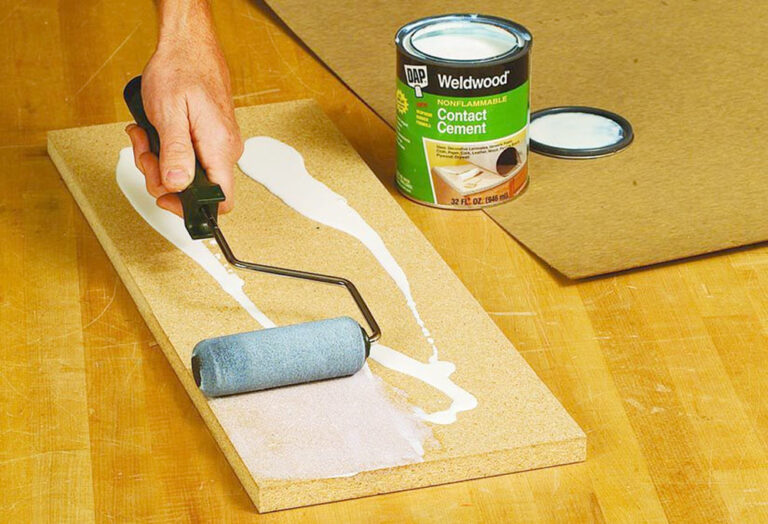MusselBound vs Mortar: Installation Guide
Glue Types Comparison
When choosing between MusselBound and traditional mortar for tile installations, it’s crucial to understand how each adheres and performs. This comparison will help determine which option suits your project best.
MusselBound Overview
MusselBound is an adhesive tile mat designed to replace traditional mortar in tile installations. It provides a “peel and stick simplicity,” which makes it ideal for beginners and DIY enthusiasts. The mat, resembling double-sided sticky tape, sticks to the wall, allowing tiles to be directly applied without the need for messy mortar or extensive drying times.
Key Features:
- Ease of use: MusselBound’s peel-and-stick design simplifies the tiling process.
- Speed: Eliminates the waiting time associated with mortar drying, enabling faster project completion.
- Cleanliness: Reduces mess as it eliminates the need for mortar mixing and application.
Mortar Application Process
Mortar, a traditional adhesive for tile installations, has been used for decades to achieve durable and long-lasting results. It involves mixing a powder with water to create a paste that adheres tiles to surfaces. This process requires skill and precision to ensure even application and proper setting.
Key Steps:
- Preparation: Surface must be clean and dry.
- Mixing: Mortar powder is mixed with water until a thick, spreadable consistency is achieved.
- Application: The mixture is spread onto the surface with a trowel, creating grooves to help the tiles adhere properly.
- Setting Tiles: Tiles are pressed into the mortar and adjusted for alignment.
- Drying: Requires a set time (often 24 hours) for the mortar to cure.
- Grouting: After the mortar sets, grout is applied to fill the gaps between tiles.
Advantages:
- Durability: Mortar provides a robust and long-lasting bond.
- Flexibility: Suitable for various types of tiles and surfaces.
- Proven Results: Traditional method trusted by professionals for its reliability.
Key Comparison
| Feature | MusselBound | Mortar |
|---|---|---|
| Ease of Use | High: Peel and stick simplicity | Moderate: Requires mixing and precise application |
| Project Speed | Fast: Minimal waiting time | Slow: Requires drying time |
| Cleanliness | High: No mortar mess | Low: Mortar mixing and application can be messy |
| Required Skill Level | Low: Beginner-friendly | High: Requires skill and experience |
| Durability | Moderate: Suitable for various applications | High: Trusted for long-lasting strength |
Choosing between MusselBound and mortar depends on your specific project requirements, skill level, and the desired outcome.
MusselBound Features
Easy Installation Process
MusselBound offers a straightforward and convenient method for tile installation, especially beneficial for beginners or those looking to save time on their projects. This adhesive tile mat simplifies the process by serving as a direct replacement for traditional mortar. Instead of the complex and often messy mortar application, MusselBound offers a “peel and stick” simplicity (Mallory Nikolaus).
The mat is like a strong, double-sided sticky tape, eliminating the need for mixing mortar and ensuring a less cluttered workspace. After peeling the backing, users can easily place the tiles onto the adhesive mat. While there is a small window for adjusting tiles once placed, the adhesive sets firmly soon after, making adjustments limited.
Compared to traditional mortar, the speed of installation with MusselBound is significantly faster. It not only eliminates the waiting time for mortar to set but also reduces cleanup time. Projects like kitchen backsplashes or bathroom walls, which might typically take days with mortar, can be completed in a fraction of the time with MusselBound.
Suitable Applications
MusselBound is versatile and suited for various applications, though it’s particularly effective for certain projects. According to Honey Built Home, MusselBound is perfect for vertical surfaces like wall tile installations. It is commonly used for areas such as kitchen backsplashes, bathroom walls, and other similar applications where traditional mortar might be cumbersome.
However, it’s important to note that MusselBound is not recommended for shower floors or areas that will be submerged in water. Its design ensures that it adheres well to bathroom conditions but avoids direct and prolonged water exposure. For areas needing strong water resistance, traditional methods or specific waterproofing materials might be more appropriate.
Suitable Applications:
- Kitchen backsplashes
- Bathroom walls
- Accent walls
- Fireplace surrounds
Not Suitable For:
- Shower floors
- Areas submerged in water
For those considering which adhesive to use, MusselBound offers numerous benefits and specific applications that make it a strong contender against traditional mortar.
MusselBound Benefits
Quick Project Completion
MusselBound is known for enabling quick and efficient project completion. This adhesive tile mat allows for a seamless installation process, significantly reducing the time required for tile projects.
Unlike traditional mortar, which involves mixing, spreading, and waiting for it to set, MusselBound offers a “peel and stick simplicity”. The adhesive tile mat provides a forgiving window of a few seconds after placing the tile to make minor adjustments, but sets firmly shortly after.
| Installation Step | Traditional Mortar | MusselBound |
|---|---|---|
| Preparation Time | Lengthy | Minimal |
| Setting Time | Hours to days | Immediate to minutes |
| Adjustment Time | Limited to none once set | Few seconds after placement |
Beginner-Friendly Option
MusselBound is an ideal option for beginners in tile installation. The ease of use and straightforward application process make it accessible for those with little to no experience.
Many DIYers prefer MusselBound over traditional mortar due to its simplicity and effectiveness. MusselBound makes projects like kitchen backsplashes and shower tiling much simpler, providing a stress-free and convenient solution for novice tile installers.
| Feature | MusselBound | Traditional Mortar |
|---|---|---|
| Ease of Use for Beginners | High | Low to Medium |
| Messiness | Low | High |
| Required Tools | Minimal | Several (mixers, trowels, etc.) |
For more tips on using MusselBound and ensuring successful tile projects, see our articles on tile adjustment technique and maintenance and grouting guidelines.
MusselBound vs. Traditional Mortar
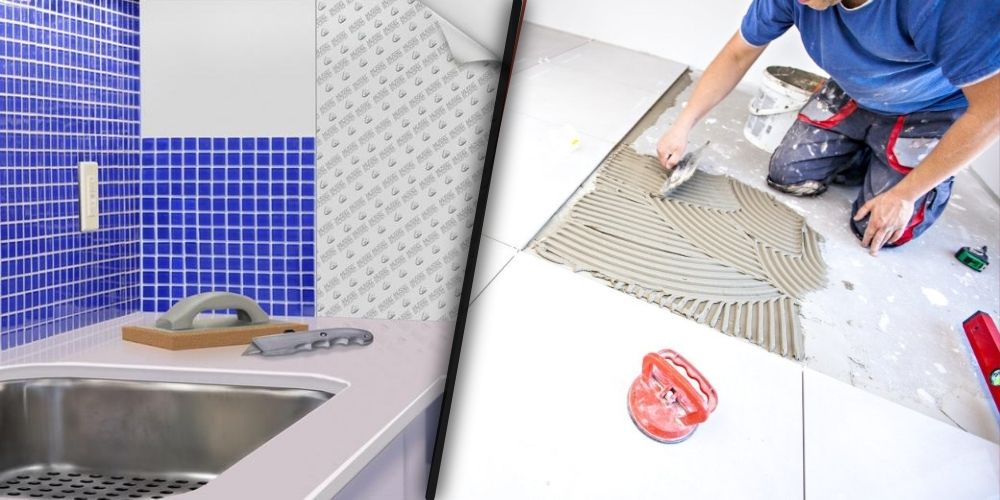
Pros and Cons
When comparing MusselBound adhesive tile mats and traditional mortar, there are several distinct advantages and disadvantages to consider for each option.
MusselBound:
Pros:
- Ease of installation: MusselBound adhesive mats are beginner-friendly, making them ideal for DIY projects.
- Time efficiency: MusselBound offers a faster tiling process, which can save a significant amount of time compared to traditional mortar.
- No mixing required: As a premixed adhesive solution, it eliminates the need for mixing and additional preparation.
- Cleaner process: MusselBound application is generally cleaner and less messier than mortar.
Cons:
- Cost: MusselBound adhesive mats are more expensive, costing about $29 per roll, compared to $30-$50 for a large premixed bucket of thin-set that could cover a larger area.
- Lifespan: Adhesive tile mats usually have a shorter lifespan of around 20 years, compared to the 50-year longevity of traditional thinset mortar or mastic adhesives (The Spruce).
- Weight limitation: MusselBound mats have a holding power of about 7 pounds per square foot, limiting their use for larger, heavier tiles.
Traditional Mortar:
Pros:
- Cost-effective: Traditional thin-set mortar is significantly cheaper, costing approximately four times less per square foot than MusselBound mats.
- High durability: Mortar provides a longer-lasting adhesive solution, often lasting upwards of 50 years.
- Strong holding power: Suitable for a wide range of tile weights and types, providing greater flexibility in design choices.
Cons:
- Complex installation: Mortar requires a more skilled application process, which can be challenging for beginners.
- Messy process: Mixing and applying mortar can be messier compared to adhesive mats, leading to more cleanup.
- Extended drying time: Mortar requires a longer curing period, delaying the project completion.
Cost Comparison
When assessing the financial aspects of MusselBound versus traditional mortar, it’s essential to consider both the initial costs and the long-term value. Below is a comparison table summarizing the costs:
| Adhesive Type | Cost per Square Foot | Initial Cost for 100 sq ft | Estimated Lifespan |
|---|---|---|---|
| MusselBound Adhesive Mat | $2 to $3 | $200 to $300 | ~20 years |
| Traditional Thin-set Mortar | $0.50 to $1 | $50 to $100 | ~50 years |
Given these figures, while MusselBound adhesive mats are more expensive initially, the time saved during installation can make it a valuable option for some users. However, traditional thin-set mortar offers a more cost-effective and longer-lasting solution, suitable for professionals and those seeking a durable and versatile adhesive.
MusselBound Application Tips
Tile Adjustment Technique
Using MusselBound adhesive tile mats offers a practical alternative to traditional mortar, making tiling easier and more efficient (Average Inspired). However, it’s important to follow specific techniques to ensure a successful installation.
Initial Placement: Lightly place each tile onto the sticky surface of the MusselBound mat. This allows for minor adjustments. There is a forgiving window of a few seconds to make any necessary corrections (Mallory Nikolaus).
Securing the Tile: Once the tile is positioned correctly, press it firmly for about 5 seconds to ensure proper adhesion. This step is crucial as the adhesive sets quickly.
Handling Gaps: Use MusselBound seam tape to cover gaps between adhesive mats. Peel back the tape to expose the sticky sides and secure it over the mat seams to prepare for tile installation.
First Row Importance: Take extra time with the first row of tiles, as it sets the foundation for the rest of the tiling project. Ensure they are aligned and level (haus & hand).
Dust Management: Wipe the backs of the tiles to remove any dust before installation. Dust can prevent the adhesive from working effectively, causing tiles to fall off during placement but not after the tiles are set.
Maintenance and Grouting Guidelines
Proper maintenance and grouting practices help in achieving long-lasting results when using MusselBound adhesive mats.
Grouting: After setting the tiles, grouting should be done to fill the gaps and provide a finished look. Use a grout float or putty knife to apply the grout evenly between the tiles. Ensure the grout fills the spaces completely to prevent any future damage.
Sealing: Sealing the grout can help prevent moisture absorption and staining, increasing the longevity of your tiling project. Follow the grout manufacturer’s instructions for the best sealant to use.
Cleaning: Regular cleaning of the tiled surface with a mild detergent and water helps maintain its appearance. Avoid abrasive cleaners that can damage the tiles or grout.
Repair: If any tile loosens or cracks over time, it can be replaced by gently removing it and cleaning the area. Apply a new piece of MusselBound mat or adhesive and press a fresh tile in place.
Understanding the nuances of using MusselBound adhesive mats ensures effective tile installation and maintenance. For more tips and guidelines, explore our internal resources on how to use shoe goo or liquid nails vs. loctite.
Considerations Before Choosing
When deciding between MusselBound adhesive mats and traditional mortar for your tiling project, it’s essential to evaluate factors such as durability, longevity, and compatibility with different tile types. This section will delve into these considerations.
Durability and Longevity
Durability and longevity are key when selecting an adhesive for tile installation. MusselBound adhesive mats and traditional mortar significantly differ in these aspects.
| Adhesive Type | Durability | Average Lifespan | Maintenance |
|---|---|---|---|
| MusselBound | Moderate | Around 20 years | More frequent upkeep needed |
| Traditional Mortar | High | Upwards of 50 years | Less frequent maintenance |
MusselBound adhesive tile mats are known for their ease of use, especially for DIY projects. However, they have a shorter lifespan of about 20 years and require more frequent maintenance, such as sealing grout lines and periodic re-grouting. Traditional mortar or thinset adhesive can last for over 50 years, generally requiring less upkeep and providing more long-term durability. These factors are crucial to consider, particularly for professionals who want to avoid callbacks for repairs.
Tile Types Compatibility
The type of tile you’re using is another critical consideration when choosing between MusselBound and mortar.
| Adhesive Type | Suitable Tile Types | Design Limitations |
|---|---|---|
| MusselBound | Smaller, lighter tiles | Not suitable for heavy/large tiles or mesh-backed mosaics, limits glass and porcelain options |
| Traditional Mortar | Suitable for most tile types | Suitable for large and heavy tiles without design limitations |
MusselBound adhesive tile mats are often limited to smaller, lighter tiles due to their holding power of about 7 pounds per square foot. This constraint can restrict design choices, as they may not be suitable for large, heavy tiles or mesh-backed mosaic sheets. Thus, for intricate and robust tile designs like popular glass and porcelain mosaics, traditional mortar tends to be more versatile and accommodating.
Additionally, MusselBound adhesive mats are not recommended for high-moisture areas, while traditional mortar provides better performance in such environments.
When deciding between MusselBound and mortar, it’s essential to weigh these considerations carefully. Understanding the nuances of durability, longevity, and tile compatibility will help you make an informed choice for your tiling project. For more information on specific adhesives and their applications, check out musselbound vs. thinset or explore types of cement adhesive.

